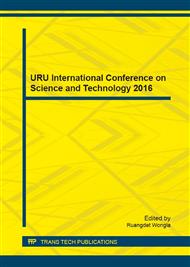[1]
Cabinet Office, A guide to Social Return on Investment, Society Media, UK, (2009).
Google Scholar
[2]
Information on https: /www. bot. or. th.
Google Scholar
[3]
Information on http: /www2. bot. or. th/statistics/ReportPage. aspx?reportID=90&language=th.
Google Scholar
[4]
Prapita Thanarak, Supply chain management of agricultural waste for biomass utilization and CO2 emission reduction in the lower northern region of Thailand, Energy Procedia, 14 (2012) 843-848.
DOI: 10.1016/j.egypro.2011.12.1021
Google Scholar
[5]
S. Keyuraphan, P. Thanarak, N. Ketjoy and W. Rakwichian, Subsidy schemes of renewable energy policy for electricity generation in Thailand, Procedia Engineering, 32 (2012) 440-448.
DOI: 10.1016/j.proeng.2012.01.1291
Google Scholar
[6]
Sayan Chakrabarty, F.I.M. Muktadir Boksh and Arpita Chakraborty, Economic viability of biogas and green self-employment opportunities, Renewable and Sustainable Energy Reviews, 28 (2013) 757–766.
DOI: 10.1016/j.rser.2013.08.002
Google Scholar
[7]
Bambang Sugiyono, Agus Purwono Suyanta and Rahbini, Biogas digester as an alternative energy strategy in the marginal villages in Indonesia, Energy Procedia, 32 (2013) 136-144.
DOI: 10.1016/j.egypro.2013.05.018
Google Scholar
[8]
Bettina Bluemling, Arthur P.J. Mol and Qin Tu, The social organization of agricultural biogas production and use, Energy Policy, 63 (2013) 10-17.
DOI: 10.1016/j.enpol.2013.08.035
Google Scholar
[9]
Sri Atmaja P. Rosyidi, Tjasa Bole-Rentel, Surya Budi Lesmana and Jazaul Ikhsan, Lessons learnt from the energy needs assessment carried out for the biogas program for rural development in Yogyakarta, Indonesia, Procedia Environmental Sciences, 20 (2014).
DOI: 10.1016/j.proenv.2014.03.005
Google Scholar
[10]
Andrew Whiting and Adisa Azapagic, Life cycle environmental impacts of generating electricity and heat from biogas produced by anaerobic digestion, Energy, 70 (2014) 181-193.
DOI: 10.1016/j.energy.2014.03.103
Google Scholar
[11]
Sara Evangelisti, Paola Lettieri, Domenico Borello and Roland Clift, Life cycle assessment of energy from waste via anaerobic digestion: A UK case study, Waste Management, 34 (2014) 226-237.
DOI: 10.1016/j.wasman.2013.09.013
Google Scholar
[12]
Peter Nabusiu Walekhwa, Drake Lars and Johnny Mugisha, Economic viability of biogas energy production from family-sized digesters in Uganda, Biomass and Bioenergy, 70 (2014) 26-39.
DOI: 10.1016/j.biombioe.2014.03.008
Google Scholar
[13]
Ratih Novi Listyawati, Christia Meidiana and Mustika Anggraeni, Evaluation of energy self-sufficient village by means of emergy indices, Procedia Environmental Sciences, 20 (2014) 30-39.
DOI: 10.1016/j.proenv.2014.03.006
Google Scholar
[14]
Yiying Jin, Ting Chen, Xin Chen and Zhixin Yu, Life-cycle assessment of energy consumption and environmental impact of an integrated food waste-based biogas plant, Applied Energy, 151 (2015) 227–236.
DOI: 10.1016/j.apenergy.2015.04.058
Google Scholar
[15]
I. Gusti Ayu Nyoman Budiasih, Social and environment accounting practices at the time of the ancient Bali, Procedia - Social and Behavioral Sciences, 219 (2016) 145–151.
DOI: 10.1016/j.sbspro.2016.04.056
Google Scholar
[16]
Kok Sin Woon, Irene M.C. Lo, Sam L.H. Chiu and Dickson Y.S. Yan, Environmental assessment of food waste valorization in producing biogas for various types of energy use based on LCA approach, Waste Management, 50 (2016) 290-299.
DOI: 10.1016/j.wasman.2016.02.022
Google Scholar
[17]
David Styles, Eduardo Mesa Dominguez and Dave Chadwick, Environmental balance of the UK biogas sector: An evaluation by consequential life cycle assessment, Science of the Total Environment, 560–561 (2016) 241–253.
DOI: 10.1016/j.scitotenv.2016.03.236
Google Scholar
[18]
Krittaphas Mongkoldhumrongkul and Prapita Thanarak, Key factors of community based biomass power plant establishment, Applied Mechanics and Materials, 839 (2016) 75-80.
DOI: 10.4028/www.scientific.net/amm.839.75
Google Scholar
[19]
Changbo Wang, Yaoqi Zhang, Lixiao Zhang and Mingyue Pang, Alternative policies to subsidize rural household biogas digesters, Energy Policy, 93 (2016) 187-195.
DOI: 10.1016/j.enpol.2016.03.007
Google Scholar
[20]
Ola Eriksson, Mattias Bisaillon, Marten Haraldsson and Johan Sundberg, Enhancement of biogas productin from food waste and sewage sludge-environmental and economic life cycle performance, Journal of Environmental Management, 175 (2016) 33-39.
DOI: 10.1016/j.jenvman.2016.03.022
Google Scholar


